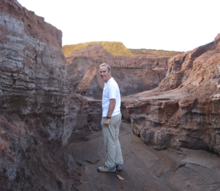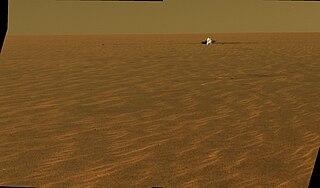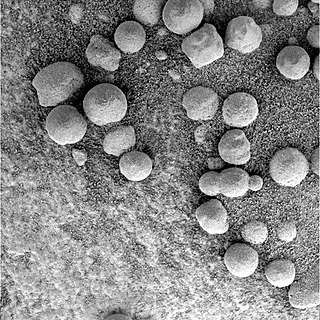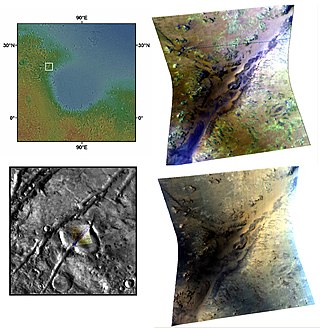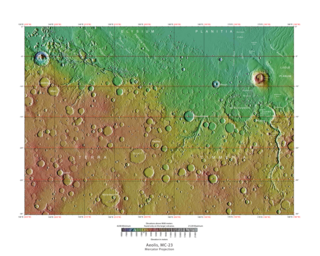Books
Grotzinger, J. P. and James, N. P., 2000, Carbonate Sedimentation and Diagenesis in the Evolving Precambrian World, Special Publication 67: SEPM (Society for Sedimentary Geology), Tulsa, OK.
Press, F., Siever, R., Grotzinger, J. P., Jordan, T. H., 2003, Understanding Earth, 4th Edition. Freeman, 567 pp.
Grotzinger, J. P., Jordan, T. H., Press, F., and Siever, R., 2006, Understanding Earth, 5th Edition, Freeman, 579 pp.
Jordan, T.H., and Grotzinger, J.P., 2008, Essential Earth, 1st Edition, Freeman, 384 pp.
Grotzinger, J. P., and Jordan, 2010, Understanding Earth, 6th Edition, Freeman, 582 pp.
Jordan, T.H., and Grotzinger, J.P., 2011, Essential Earth, 2nd Edition, Freeman, 391 pp.
Grotzinger, J. P., and Milliken, R. E. (eds). 2012, Sedimentary Geology of Mars, Special Publication 102: SEPM (Society for Sedimentary Geology), Tulsa, OK.
Grotzinger, J. P., Vasavada, A., and Russell, C (eds), 2013, Mars Science Laboratory Mission. Springer, London, 763 pp.
Selected Papers
Mars: Grotzinger, J.P., and 71 others (2014), A habitable fluvio-lacustrine environment at Gale Crater, Mars. Science, v. 343, DOI: 10.1126/science.1242777
Grotzinger, J. P. (2014) Habitability, Taphonomy, and the Search for Organic Carbon on Mars. Science, v. 343, DOI:10.1126/science.1248097.
Farley, K.A., Malespin, C., Mahaffy, P., Grotzinger, and 29 others (2014), In-situ Radiometric and Exposure age dating of the Martian surface. Science, v. 343, DOI: 10.1126/science.1247166
Grotzinger, J. P., (2013), Analysis of surface materials by the Curiosity rover, Science, 341, DOI: 10.1126/science.1244258
Grotzinger J. P., Hayes A. G., Lamb M. P., and McLennan S. M. (2013) Sedimentary processes on Earth, Mars, Titan, and Venus. In Comparative Climatology of Terrestrial Planets (S. J. Mackwell et al., eds.), p. 439-472 Univ. of Arizona, Tucson
Williams, R.M.E., Grotzinger, J.P., and 35 others (2013), Martian fluvial conglomerates at Gale Grater., 2013, Science 340, 1068-1072.
Grotzinger, J.P., and 25 others, 2013 Mars Science Laboratory Mission and science investigation. In, Grotzinger, J. P., Vasavada, A., and Russell, C (eds) Mars Science Laboratory Mission. Springer, London, pp. 3–54. DOI 10.1007/s11214-012-9892-2
Grotzinger, J.P., and Vasavada, A., 2012, Reading the red planet. Scientific American, July, 2012, p. 40-43.
Grotzinger JP, Milliken RE. 2012. The Sedimentary Rock Record of Mars: Distribution, Origins, and Global Stratigraphy. In Grotzinger JP, Milliken RE (Editors). Sedimentary Geology of Mars, Special Publication 102: SEPM (Society for Sedimentary Geology), Tulsa, OK. p. 1–48.
Grotzinger, J. P. et al., 2011, Mars Sedimentary Geology: Key Concepts and Outstanding Questions. Astrobiology, v 11, p. 77-87.
Milliken, R., Grotzinger, J., and Thomson, B., 2010, The paleoclimate of Mars from the stratigraphic record in Gale Crater. Geophysical Research Letters, v. 37, L04201, doi:10.1029/2009GL041870
Metz, J.M., Grotzinger, J.P., Rubin, D.M., Lewis, K.W., Squyres, S.W., and Bell III, J.F., 2009. Sulfate-rich eolian and wet interdune deposits, Erebus crater, Meridiani Planum, Mars. Journal of Sedimentary Research, 79, p. 247-264.
Grotzinger, J. P., 2009, Mars Exploration, Comparative Planetary History, and the Promise of Mars Science Laboratory. Nature Geoscience, v. 2, p. 1-3.
McLennan, S. M., Bell III, J. F., Calvin, W., Grotzinger, J. P., and 28 others, 2005, Provenance and diagenesis of the evaporite-bearing Burns formation, Meridiani Planum, Mars. Earth and Planetary Science Letters, v 240, 95-121.
Grotzinger, J.P., and 16 others, 2005, Stratigraphy and Sedimentology of a Dry to Wet Eolian Depositional System, Burns Formation, Meridiani Planum, Mars: Earth and Planetary Science Letters, v. 240, p. 11-72.
Squyres, S., Grotzinger, J. P., Bell, J. F. III, Calvin, W., and 14 others, 2004, In-situ evidence for an aqueous environment at Meridiani Planum, Mars. Science, v. 306, p. 1709-1714.
Earth: Bergmann, K.D., Grotzinger, J.P., and Fischer, W. W., 2013, Biological influences on seafloor carbonate precipitation. Palaios, v. 20, DOI: 10.2110/palo.2012.p12-088r
Lee C, Fike DA, Love GD, Sessions AL, Grotzinger JP, Summons RE, Fischer WW (2013) Carbon isotopes and lipid biomarkers from organic-rich facies of the Shuram Formation, Sultanate of Oman, Geobiology, doi: 10.1111/gbi.12045.
Bontognali TRR, Sessions AL, Allwood AC, Fischer WW, Grotzinger JP, Summons RE, Eiler JM (2012) Sulfur isotopes of organic matter preserved in 3.45 Gyr-old stromatolites reveal microbial metabolism, Proceedings of the National Academy of Sciences, 109, 15146-15151.
Wilson, J.P., Grotzinger, J.P., et al., 2012, Deep-water incised valley deposits at the Ediacaran-Cambrian boundary in southern Namibia contain abundant Treptichnus Pedum. Palaios, v. 27, p. 252-273.
Maloof, A. C., and Grotzinger, J. P., 2011, The Holocene shallowing-upward parasequence of north-west Andros Island, Bahamas. Sedimentology, doi: 10.1111/j.1365-3091.2011.01313.x
Butterfield, N. J., and Grotzinger, J. P., 2012, Palynology of the Huqf Supergroup, Oman. Geological Society of London Special Publication, v. 366, DOI: 10.1144/SP366.10.
Bristow, T., Bonifacie, M., Derkowski, A., Eiler, J., and Grotzinger, J. P., 2011, A hydrothermal origin for isotopically anomalous cap dolostone cements from South China. Nature, 474, 68-72.
Love, G., Grosjean, E., Stalvies, C., Fike, D., Grotzinger, J., and 8 others, 2009, Fossil steroids record the appearance of Demospongiae during the Cryogenian period. Nature, v. 457, p. 718-721.
Grotzinger, J. P., and Miller, R., 2008, The Nama Group. In, R. Miller (ed.), The Geology of Namibia. Geological Society of Namibia Special Publication, Volume 2, p. 13-229 – 13-272.
Schröder, S. and Grotzinger, J. P., 2007, Evidence for anoxia at the Ediacaran-Cambrian boundary: The record of redox-sensitive trace elements and rare-earth elements in Oman. Journal of the Geological Society of London, v. 164, p. 175-187.
Fike, D.A., Grotzinger, J.P., Pratt, L.M., and Summons, R.E., 2006, Oxidation of the Ediacaran Ocean. Nature, v. 444, p. 744-747.
Grotzinger, J. P., Adams, E., and Schröder, S., 2005, Microbial-metazoan reefs of the terminal Proterozoic Nama Group (ca. 550-543 Ma), Namibia. Geological Magazine, v. 142, p. 499-517.
Grotzinger, J. P and Knoll, A. H. 1999. Stromatolites: Evolutionary mileposts or environmental dipsticks? Annual Review of Earth and Planetary Sciences, v. 27, p. 313-358.
Grotzinger, J. P. , Watters, W. and Knoll, A. H., 2000, Calcified metazoans in thrombolite-stromatolite reefs of the terminal Proterozoic Nama Group, Namibia. Paleobiology, v. 26, p. 334-359.
Sumner, D. Y. and Grotzinger, J. P., 1996. Were kinetics of Archean calcium carbonate precipitation related to oxygen concentration? Geology, v. 24, p. 119-122.
Grotzinger, J. P. and Rothman, D. H., 1996. An abiotic model for stromatolite morphogenesis. Nature, v. 383, p. 423-425.
Grotzinger, J. P. Trends in Precambrian carbonate sediments and their implication for understanding evolution. in, Bengtson, S. (ed.), Early Life on Earth, Columbia University Press, p. 245-258 .
Grotzinger, J.P. and Royden, L.H. 1990. Elastic strength of the Slave craton at 1.9 Gyr and implications for the thermal evolution of the continents. Nature, v. 347, p. 64-66.
Grotzinger, John P. 1989. Facies and evolution of Precambrian carbonate depositional systems: emergence of the modern platform archetype, in, SEPM Special Publication 44, p. 79-106.
Christie-Blick, N., Grotzinger, J.P., and von der Borch, C.C. 1988. Sequence stratigraphy in Proterozoic Successions. Geology, v. 16, p. 100-104.
Grotzinger, J.P. 1986. Upward shallowing platform cycles: A response to 2.2 billion years of low-amplitude, high-frequency (Milankovitch band) sea level oscillations. Paleoceanography, v. 1, no. 4, p. 403-416.
Grotzinger, J.P. and Read, J.F. 1983. Evidence for primary aragonite precipitation, early Proterozoic (1.9 Ga) Rocknest Dolomite, Wopmay Orogen, northwest Canada. Geology, v.11, n. 12, p. 710-713.
